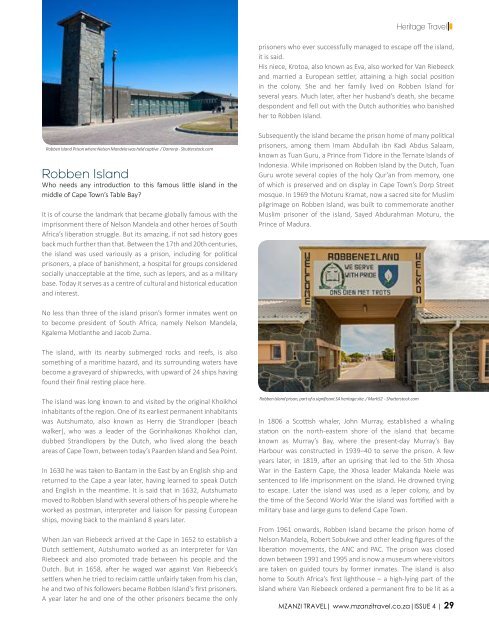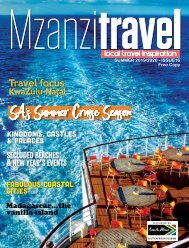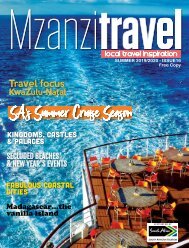Create successful ePaper yourself
Turn your PDF publications into a flip-book with our unique Google optimized e-Paper software.
Heritage Travel<br />
prisoners who ever successfully managed to escape off the island,<br />
it is said.<br />
His niece, Krotoa, also known as Eva, also worked for Van Riebeeck<br />
and married a European settler, attaining a high social position<br />
in the colony. She and her family lived on Robben Island for<br />
several years. Much later, after her husband’s death, she became<br />
despondent and fell out with the Dutch authorities who banished<br />
her to Robben Island.<br />
Robben Island Prison where Nelson Mandela was held captive / Darrenp - Shutterstock.com<br />
Robben Island<br />
Who needs any introduction to this famous little island in the<br />
middle of Cape Town’s Table Bay?<br />
It is of course the landmark that became globally famous with the<br />
imprisonment there of Nelson Mandela and other heroes of South<br />
Africa’s liberation struggle. But its amazing, if not sad history goes<br />
back much further than that. Between the 17th and 20th centuries,<br />
the island was used variously as a prison, including for political<br />
prisoners, a place of banishment, a hospital for groups considered<br />
socially unacceptable at the time, such as lepers, and as a military<br />
base. Today it serves as a centre of cultural and historical education<br />
and interest.<br />
Subsequently the island became the prison home of many political<br />
prisoners, among them Imam Abdullah ibn Kadi Abdus Salaam,<br />
known as Tuan Guru, a Prince from Tidore in the Ternate Islands of<br />
Indonesia. While imprisoned on Robben Island by the Dutch, Tuan<br />
Guru wrote several copies of the holy Qur’an from memory, one<br />
of which is preserved and on display in Cape Town’s Dorp Street<br />
mosque. In 1969 the Moturu Kramat, now a sacred site for Muslim<br />
pilgrimage on Robben Island, was built to commemorate another<br />
Muslim prisoner of the island, Sayed Abdurahman Moturu, the<br />
Prince of Madura.<br />
No less than three of the island prison’s former inmates went on<br />
to become president of South Africa, namely Nelson Mandela,<br />
Kgalema Motlanthe and Jacob Zuma.<br />
The island, with its nearby submerged rocks and reefs, is also<br />
something of a maritime hazard, and its surrounding waters have<br />
become a graveyard of shipwrecks, with upward of 24 ships having<br />
found their final resting place here.<br />
The island was long known to and visited by the original Khoikhoi<br />
inhabitants of the region. One of its earliest permanent inhabitants<br />
was Autshumato, also known as Herry die Strandloper (beach<br />
walker), who was a leader of the Gorinhaikonas Khoikhoi clan,<br />
dubbed Strandlopers by the Dutch, who lived along the beach<br />
areas of Cape Town, between today’s Paarden Island and Sea Point.<br />
In 1630 he was taken to Bantam in the East by an English ship and<br />
returned to the Cape a year later, having learned to speak Dutch<br />
and English in the meantime. It is said that in 1632, Autshumato<br />
moved to Robben Island with several others of his people where he<br />
worked as postman, interpreter and liaison for passing European<br />
ships, moving back to the mainland 8 years later.<br />
When Jan van Riebeeck arrived at the Cape in 1652 to establish a<br />
Dutch settlement, Autshumato worked as an interpreter for Van<br />
Riebeeck and also promoted trade between his people and the<br />
Dutch. But in 1658, after he waged war against Van Riebeeck’s<br />
settlers when he tried to reclaim cattle unfairly taken from his clan,<br />
he and two of his followers became Robben Island’s first prisoners.<br />
A year later he and one of the other prisoners became the only<br />
Robben Island prison, part of a significant SA heritage site. / Mark52 - Shutterstock.com<br />
In 1806 a Scottish whaler, John Murray, established a whaling<br />
station on the north-eastern shore of the island that became<br />
known as Murray’s Bay, where the present-day Murray’s Bay<br />
Harbour was constructed in 1939–40 to serve the prison. A few<br />
years later, in 1819, after an uprising that led to the 5th Xhosa<br />
War in the Eastern Cape, the Xhosa leader Makanda Nxele was<br />
sentenced to life imprisonment on the island. He drowned trying<br />
to escape. Later the island was used as a leper colony, and by<br />
the time of the Second World War the island was fortified with a<br />
military base and large guns to defend Cape Town.<br />
From 1961 onwards, Robben Island became the prison home of<br />
Nelson Mandela, Robert Sobukwe and other leading figures of the<br />
liberation movements, the ANC and PAC. The prison was closed<br />
down between 1991 and 1995 and is now a museum where visitors<br />
are taken on guided tours by former inmates. The island is also<br />
home to South Africa’s first lighthouse – a high-lying part of the<br />
island where Van Riebeeck ordered a permanent fire to be lit as a<br />
MZANZI TRAVEL| www.mzanzitravel.co.za|ISSUE 4 | 29

















